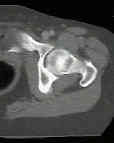- Discussion:
- femoral version is defined as the angular difference between axis of femoral neck and the transcondylar axis of the knee;
- excessive femoral anteversion (medial femoral torsion) is most common cause of in-toeing that first presents in early childhood;
- it is twice as common in girls as in boys, it is nearly always symmetrical, and it is often familial;
- tripping as a result of crossing the feet may occur, and child may be teased by peers because of pigeon-toed gait and the awkward
running pattern;
- normal values:
- on average, femoral anteversion ranges from 30-40 deg at birth and decreases progressively throughout growth to about 15 deg at
skeletal maturation;
- in adults, anteversion averages between 8 and 14 deg, w/ an average of 8 degrees in men and 14 degrees in women;
- diff dx of intoeing:
- metatarsus adductus
- tibial torsion
- femoral anteversion
- natural history:
- parents usually become concerned after the child reaches age 3 years;
- in-toeing secondary to medial femoral torsion is most pronounced between ages 4 to 6 years, but subsquently improves during
later childhood, averaging about 1.5 degrees of correction per year;
- this is partially due to the fact that medial hip rotation is greatest during early childhood, but then declines with increasing age,
decreasing about 2 or 3 degrees per year;
- if assoc w/ internal tibial torsion, femoral anteversion may lead to patellofemoral subluxation due to an increase in the Q angle;
- both the decrease in femoral anteversion and decrease in medial rotation, result in near complete resolution of the intoeing in
more than 80 % of affected children, usually by age 10 years;
- additional concious compsensation may occur during adolescence;
- Exam:
- increased medial rotation and decreased lateral rotation noted on exam of child with an intoeing gait with patellae medially rotated;
- medial rotation of thigh in extension exceeding 70 deg is abnormal;
- if hip rotation is asymmetric, then consider DDH;
- gait:

- child ambulates w/ patella medially rotated, and runs in an awkward pattern;
- running is characterized by medial rotation of thighs during swing phase, which causes outward rotation of legs;
- Reider Test:
- prominence of the greater trochanter indicates axis of the femoral neck;
- noting the position of the patella, an accurate determination of the femoral anteversion can be determined;
- Operative Indications:
- procedure should be performed only after age of eight to ten years, for persistent, severe deformity;
- child should have more than 50 degrees of measured anteversion & more than 80 degrees of medial hip rotation
Clinical determination of femoral anteversion. A comparison with established techniques.
Intertrochanteric versus supracondylar osteotomy for severe femoral anteversion.
Medial femoral torsion and osteoarthritis.
Lower-extremity rotational problems in children. Normal values to guide management.
The anatomy and functional axes of the femur.
Femoral anteversion and physical properties in adolescent and adult life.

